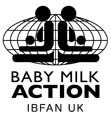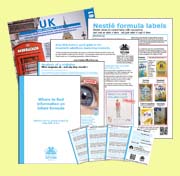
What’s inappropriate promotion?
The Resolution passed at the 2012 World Health Assembly Resolution (WHA) called for 'clarification and guidance on the inappropriate marketing of foods for infants and young children'.
WHO convened a Working Group in June to explore this issue, and has arrived at 5 criteria that could be used to inform policies. We hope that these will be highlighted in a new resolution at the forthcoming WHA in May.
Promotion is inappropriate if:
● it undermines recommended breastfeeding practices;
● contributes to childhood obesity and noncommunicable diseases;
● the product does not make an appropriate contribution to infant and young child nutrition in the country;
● it undermines the use of suitable home-prepared and/or local foods;
● it is misleading, confusing, or could lead to inappropriate use.
See Annex 2, Page 10 on WHO's Report by the Secretariat on Maternal, infant and young child nutrition (EB134/15)
STAG report
WHO Report on Code monitoring

The report is based on a questionnaire sent to governments who reported: '...consistent, repeated, systematic violations by the industry are common concerns of countries. Very aggressive direct marketing or indirect advertisements to mothers exist. In some instances countries reported that the industry resisted all provisions of regulations, and this resistance is sometimes expressed as pressure on government to limit implementation or upgrading/updating of the law.'
● The original version contained errors that have been rectified, so download the current version.
Investing in breastfeeding 
IBFAN has produced a new tool that could help governments to fulfill their obligations to provide the environment women need to breastfeed. Formula feeding is a heavy burden on the planet and people, while breastfeeding is a valuable national asset which has great economic worth, saving lives and avoiding health costs. In many countries the investment of resources for breastfeeding is insufficient and mostly sustained by mothers and volunteers. It’s high time this was rectified.
WHO Statement on Follow-on Formula
The World Health Organisation’s long-awaited statement on follow-up formula, published in July, reaffirmed that follow-up formulas are not necessary, are unsuitable as a replacement for breastmilk after 6 months and are covered by World Health Assembly marketing requirements.
Even though follow-up formula is not necessary, and is unsuitable when used as a breastmilk replacement, it is marketed in a way that may cause confusion and have a negative impact on breastfeeding.... while follow-up formula may not be explicitly promoted as a breastmilk substitute....packaging, branding and labelling may induce mothers to use follow-up formula in the first six months of life and/or to stop breastfeeding after this period. If follow-up formula is marketed or otherwise represented to be suitable, with or without modification, for use as a partial or total replacement for breastmilk, it is covered by the Code. In addition, where follow-up formula is otherwise represented in a manner which results in such product being perceived or used as a partial or total replacement for breastmilk, such product also falls within the scope of the Code.








